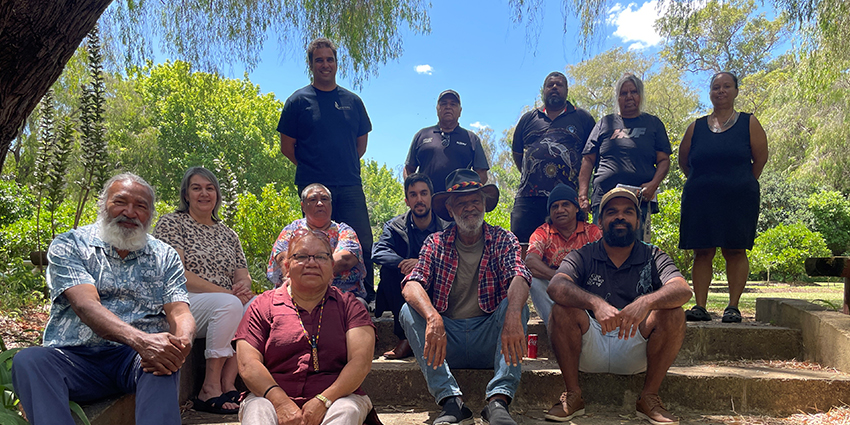This case study relates to Action 1 in the Kep Katitjin – Gabi Kaadadjan Waterwise action plan 3 delivered by the Department of Water and Environmental Regulation and Water Corporation.
Bindjareb Djilba Kaadadjan Bidi yarning circle is gathering to heal waterways in Bindjareb country
Bindjareb Noongar Elders and young leaders come together from the Mandurah, Serpentine, Pinjarra, Waroona, and Harvey areas to participate in a Bindjareb-led yarning and governance circle – the Bindjareb Djilba Kaadadjan Bidi (Peel-Harvey estuary knowledge pathway). The yarning circle oversees our own overarching water plan the Bindjareb Gabi Wonga (Bindjareb Water Story) and the implementation of several Bindjareb-led actions in the Bindjareb Djilba (Peel-Harvey estuary) Protection Plan. The Bindjareb Djilba Kaadadjan Bidi yarning circles enable us to get together just like our old people who walked our country did. We are more resilient and stronger together for our Wirrin (spirit), boodja (country) and baalap (people).
Healthy Estuaries WA and the Bindjareb Djilba Protection Plan are walking with us in our Bring Together, Walk Together journey, putting culture first and listening to Bindjareb-led ways to address the challenges we face in looking after our important waterways. Together, with our partner Aboriginal organisations – Winjan Aboriginal Corporation, Murray Districts Aboriginal Association, Harvey Aboriginal Corporation and Waroona Aboriginal & Torres Strait Islander Corporation – we are achieving moorditj (great) outcomes for our people and waterways.
Mapping country to preserve cultural knowledge for future generations and empower our people in decision-making to heal the waterways
The Bindjareb Djilba Kaadadjan Bidi yarning circle is leading several initiatives on the journey to heal waterways, including mapping country to preserve cultural knowledge for future generations and empower our people in decision-making. In 2023 we engaged Winyama Pty Ltd to build our geospatial tool, the Bindjareb Kaadadjan Mia (the Bindjareb knowledge hub). The Bindjareb Kaadadjan Mia is owned and managed by our partner Aboriginal corporations to protect our cultural intellectual property. The direct-to-digital cultural mapping process can now be undertaken by our people, for our people. The Bindjareb Kaadadjan Mia is bringing about many benefits and has wide application to empower our people. Our geospatial tool enables us to:
- engage our elders to share their lived experiences and cultural knowledge
- encourage truth telling and healing
- share cultural knowledge with our young people
- train our young people to become geospatial professionals
- get our stories back and keep them safe for future generations
- map country to identify priority places to protect and manage
- plan and record activities of our Aboriginal Ranger Program
- keep records for our strategic projects
- share high-level cultural information to partners to embed cultural knowledge and values into decision-making
- better understand the cumulative impacts of land uses on cultural values.
The importance of cultural knowledge in the journey to heal waterways
Bindjareb people have looked after the Djilba (estuary) for more than 60,000 years based on governance and lore. We have a continuing life commitment and cultural responsibility to the preservation of this area, and it holds great significance to us. The history of occupation has been unbroken where Bindjareb people have gathered for ceremonies along the estuary and the Harvey, Murray, and Serpentine rivers to hunt, fish, camp and look after country in rhythm with the Noongar Six Seasons. As we face the challenges of climate change and a drying climate, our cultural knowledge is important in the walking together journey to heal waterways.
The Bindjareb Djilba Kaadadjan Bidi yarning circle is funded by the Bindjareb Djilba Protection Plan and Healthy Estuaries WA program – State Government initiatives to improve the health of our estuaries.



